Topographic Correction to Landsat Imagery through Slope Classification by Applying the SCS + C Method in Mountainous Forest Areas
Abstract
:1. Introduction
1.1. Background
1.2. The C Parameter
2. Materials and Methods
2.1. Study Area and Dataset
2.2. Overview
2.3. Correction C Parameter Calculation
2.4. Topographic Correction
2.5. Qualitative Validation
2.6. Quantitative Validation
3. Results and Discussion
3.1. C(i,j) Parameters
3.2. Qualitative Validation
3.3. Quantitative Validation
4. Conclusions
Future Research Lines
Supplementary Materials
Acknowledgments
Author Contributions
Conflicts of Interest
References
- Proy, C.; Tanre, D.; Deschamps, P. Evaluation of topographic effects in remotely sensed data. Remote Sens. Environ. 1989, 30, 21–32. [Google Scholar] [CrossRef]
- Reese, H.; Olsson, H. C-correction of optical satellite data over alpine vegetation areas: A comparison of sampling strategies for determining the empirical c-parameter. Remote Sens. Environ. 2011, 115, 1387–1400. [Google Scholar] [CrossRef]
- Holben, B.N.; Justice, C.O. The topographic effect on spectral response from nadir-pointing sensors. Photogramm. Eng. Remote Sens. 1980, 46, 1191–1200. [Google Scholar]
- Teillet, P.; Guindon, B.; Goodenough, D. On the slope-aspect correction of multispectral scanner data. Can. J. Remote Sens. 1982, 8, 84–106. [Google Scholar] [CrossRef]
- Justice, C.O.; Wharton, S.W.; Holben, B. Application of digital terrain data to quantify and reduce the topographic effect on Landsat data. Int. J. Remote Sens. 1981, 2, 213–230. [Google Scholar] [CrossRef]
- Soenen, S.A.; Peddle, D.R.; Coburn, C.A. A Modified Sun-Canopy-Sensor Topographic Correction in Forested Terrain. IEEE Trans. Geosci. Remote Sens. 2005, 43, 2148–2159. [Google Scholar] [CrossRef]
- Itten, K.I.; Meyer, P. Geometric and radiometric correction of TM data of mountainous forested areas. IEEE Trans. Geosci. Remote Sens. 1993, 31, 764–770. [Google Scholar] [CrossRef]
- Singh, S.; Talwar, R. A Systematic Survey on Different Topographic Correction Techniques for Rugged Terrain Satellite Imagery. Int. J. Electron. Commun. Technol. 2013, 4, 14–18. [Google Scholar]
- Moreira, E.P.; Valeriano, M.M. Application and evaluation of topographic correction methods to improve land cover mapping using object-based classification. Int. J. Appl. Earth Obs. Geoinf. 2014, 32, 208–217. [Google Scholar] [CrossRef]
- Smith, J.; Lin, T.L.; Ranson, K. The Lambertian assumption and Landsat data. Photogramm. Eng. Remote Sens. 1980, 46, 1183–1189. [Google Scholar]
- Civco, D.L. Topographic normalization of Landsat Thematic Mapper digital imagery. Photogramm. Eng. Remote Sens. 1989, 55, 1303–1309. [Google Scholar]
- Karathanassi, V.; Andronis, V.; Rokos, D. Evaluation of the topographic normalization methods for a Mediterranean forest area. Int. Arch. Photogramm. Remote Sens. 2000, 33, 654–661. [Google Scholar]
- Riaño, D.; Chuvieco, E.; Salas, J.; Aguado, I. Assessment of different topographic corrections in Landsat-TM data for mapping vegetation types. IEEE Trans. Geosci. Remote Sens. 2003, 41, 1056–1061. [Google Scholar] [CrossRef]
- Uribe, N.; Oberthür, T.; Hyman, G. Valoración de los Diferentes Métodos de Correción Topográfica en Imágenes de Satélite Aplicado a la Respuesta Espectral del Café. Available online: http://ciat-library.ciat.cgiar.org/articulos_ciat/poster_natalia.pdf (accessed on 8 September 2017).
- Couturier, S.; Gastellu-Etchegorry, J.; Martin, E.; Patiño, P. Building a forward-mode three-dimensional reflectance model for topographic normalization of high-resolution (1–5 m) imagery: Validation phase in a forested environment. IEEE Trans. Geosci. Remote Sens. 2013, 51, 3910–3921. [Google Scholar] [CrossRef]
- Fan, Y.; Koukal, T.; Weisberg, P.J. A sun–crown–sensor model and adapted C-correction logic for topographic correction of high resolution forest imagery. ISPRS J. Photogramm. Remote Sens. 2014, 96, 94–105. [Google Scholar] [CrossRef]
- Gu, D.; Gillespie, A. Topographic normalization of Landsat TM images of forest based on subpixel sun–canopy–sensor geometry. Remote Sens. Environ. 1998, 64, 166–175. [Google Scholar] [CrossRef]
- Meyer, P.; Itten, K.I.; Kellenberger, T.; Sandmeier, S.; Sandmeier, R. Radiometric corrections of topographically induced effects on Landsat TM data in an alpine environment. ISPRS ISPRS J. Photogramm. Remote Sens. 1993, 48, 17–28. [Google Scholar] [CrossRef]
- Allen, T.R. Topographic normalization of Landsat Thematic Mapper data in three mountain environments. Geocarto. Int. 2000, 15, 15–22. [Google Scholar] [CrossRef]
- Ekstrand, S. Landsat TM-based forest damage assessment: Correction for topographic effects. Photogramm. Eng. Remote Sens. 1996, 62, 151–162. [Google Scholar]
- Blesius, L.; Weirich, F. The use of the Minnaert correction for land-cover classification in mountainous terrain. Int. J. Remote Sens. 2005, 26, 3831–3851. [Google Scholar] [CrossRef]
- Colby, J.D. Topographic normalization in rugged terrain. Photogramm. Eng. Remote Sens. 1991, 57, 531–537. [Google Scholar]
- Bishop, M.; Colby, J. Anisotropic reflectance correction of SPOT-3 HRV imagery. Int. J. Remote Sens. 2002, 23, 2125–2131. [Google Scholar] [CrossRef]
- Zhang, Y. Normalization of Landsat TM Imagery by Atmospheric Correction for Forest Scenes in Sweden; Swedish University of Agricultural Sciences, Remote Sensing Laboratory: Umeå, Sweden, 1989; 28p. [Google Scholar]
- Kriebel, K.T. On the variability of the reflected radiation field due to differing distributions of the irradiation. Remote Sens. Environ. 1975, 4, 257–264. [Google Scholar] [CrossRef]
- Kimes, D.S.; Kirchner, J.A. Modeling the Effects of Various Radiant Transfers in Mountainous Terrain on Sensor Response. IEEE Trans. Geosci. Remote Sens. 1981, GE-19, 100–108. [Google Scholar] [CrossRef]
- Leprieur, C.; Durand, J.; Peyron, J. Influence of topography on forest reflectance using Landsat Thematic Mapper and digital terrain data. Photogramm. Eng. Remote Sens. 1988, 54, 491–496. [Google Scholar]
- Thomson, A.; Jones, C. Effects of topography on radiance from upland vegetation in North Wales. Int. J. Remote Sens. 1990, 11, 829–840. [Google Scholar] [CrossRef]
- Tokola, T.; Sarkeala, J.; Van der Linden, M. Use of topographic correction in Landsat TM-based forest interpretation in Nepal. Int. J. Remote Sens. 2001, 22, 551–563. [Google Scholar] [CrossRef]
- Soares-Filho, B.S.; Cerqueira, G.C.; Pennachin, C.L. DINAMICA—A stochastic cellular automata model designed to simulate the landscape dynamics in an Amazonian colonization frontier. Ecol. Model 2002, 154, 217–235. [Google Scholar] [CrossRef]
- Soares-Filho, B.S.; Rodrigues, H.O.; Costa, W. Modeling Environmental Dynamics with Dinamica EGO; Centro de Sensoriamento Remoto, Universidade Federal de Minas Gerais: Belo Horizonte, Minas Gerais, Brazil, 2009; Volume 115. [Google Scholar]
- CSR-UFMG. What Is Dinamica EGO? Available online: http://csr.ufmg.br/dinamica/ (accessed on 7 September 2017).
- Notimex En Guerrero, la Mina más Grande de oro de América Latina. Available online: http://www.cronica.com.mx/notas/2005/212974.html (accessed on 7 September 2017).
- Instituto Nacional de Estadística y Geografía (INEGI). Guía Para la Interpretación de Cartografía. Uso del Suelo y Vegetación. Escala 1:250, Serie IV; Instituto Nacional de Estadística y Geografía: Aguascalientes, Mexico, 2012; p. 126. [Google Scholar]
- Victoria, H.A.; Niño, A.M.; Rodríguez, A.J.A. La serie IV de uso del suelo y vegetación escala 1:250,000 de INEGI, información del periodo 2007. In La Política de Ordenamiento Territorial en Mexico: de la Teoría a la Práctica. UNAM, ICG, CIGA, INECC-SEMARNAT; Sánchez, S.M.T., Bocco, V.G., Casado, I.J.M., Eds.; La política de ordenamiento territorial en México: de la teoría a la práctica, Instituto de Geografía, Centro de Investigaciones en Geografía Ambiental, UNAM, Secretaría de Medio Ambiente y Recursos Naturales (SEMARNAT), Instituto Nacional de Ecología y Cambio Climático (INECC): D.F., Mexico, 2013; pp. 243–267. [Google Scholar]
- Instituto Nacional de Estadística y Geografía (INEGI). Guía Para la Interpretación de Cartografía uso del Suelo y Vegetación Escala 1:250,000: Serie V; Cartografía—Estudio y enseñanza, Ed.; Instituto Nacional de Estadística y Geografía: Aguascalientes, Mexico, 2015; p. 195. [Google Scholar]
- United States Geological Survey (USGS). Landsat 4–7 Climate Data Record (CDR) Surface Reflectance, Product Guide; Version 6.0; Department of the Interior U.S. Geological Survey: Reston, VA, USA, 2015.
- United States Geological Survey (USGS). Provisional Landsat 8 Surface Reflectance Product, Product Guide; Version 1.7; Department of the Interior U.S. Geological Survey: Reston, VA, USA, 2015.
- United States Geological Survey (USGS). What Are the Band Designations for the Landsat Satellites? Available online: https://landsat.usgs.gov/what-are-band-designations-landsat-satellites (accessed on 7 September 2017).
- Masek, J.G.; Vermote, E.F.; Saleous, N.E.; Wolfe, R.; Hall, F.G.; Huemmrich, K.F.; Gao, F.; Kutler, J.; Lim, T. A Landsat surface reflectance dataset for North America, 1990–2000. IEEE Geosci. Remote Sens. Lett. 2006, 3, 68–72. [Google Scholar] [CrossRef]
- Bannari, A.; Morin, D.; Bonn, F.; Huete, A. A review of vegetation indices. Remote Sens. Rev. 1995, 13, 95–120. [Google Scholar] [CrossRef]
- Gilabert, M.A.; González-Piqueras, J.; García-Haro, J. Acerca de los índices de vegetación. Rev. Teledetec. 1997, 8, 1095–1108. [Google Scholar]
- Ge, H.; Lu, D.; He, S.; Xu, A.; Zhou, G.; Du, H. Pixel-based Minnaert correction method for reducing topographic effects on a Landsat 7 ETM image. Photogramm. Eng. Remote Sens. 2008, 74, 1343–1350. [Google Scholar] [CrossRef]
- Shepherd, J.; Dymond, J. Correcting satellite imagery for the variance of reflectance and illumination with topography. Int. J. Remote Sens. 2003, 24, 3503–3514. [Google Scholar] [CrossRef]
- Wang, Z.; Bovik, A.C.; Sheikh, H.R.; Simoncelli, E.P. Image quality assessment: From error visibility to structural similarity. IEEE Trans. Image Process. 2004, 13, 600–612. [Google Scholar] [CrossRef] [PubMed]
- Hantson, S.; Chuvieco, E. Evaluation of different topographic correction methods for Landsat imagery. Int. J. Appl. Earth Obs. Geoinf. 2011, 13, 691–700. [Google Scholar] [CrossRef]

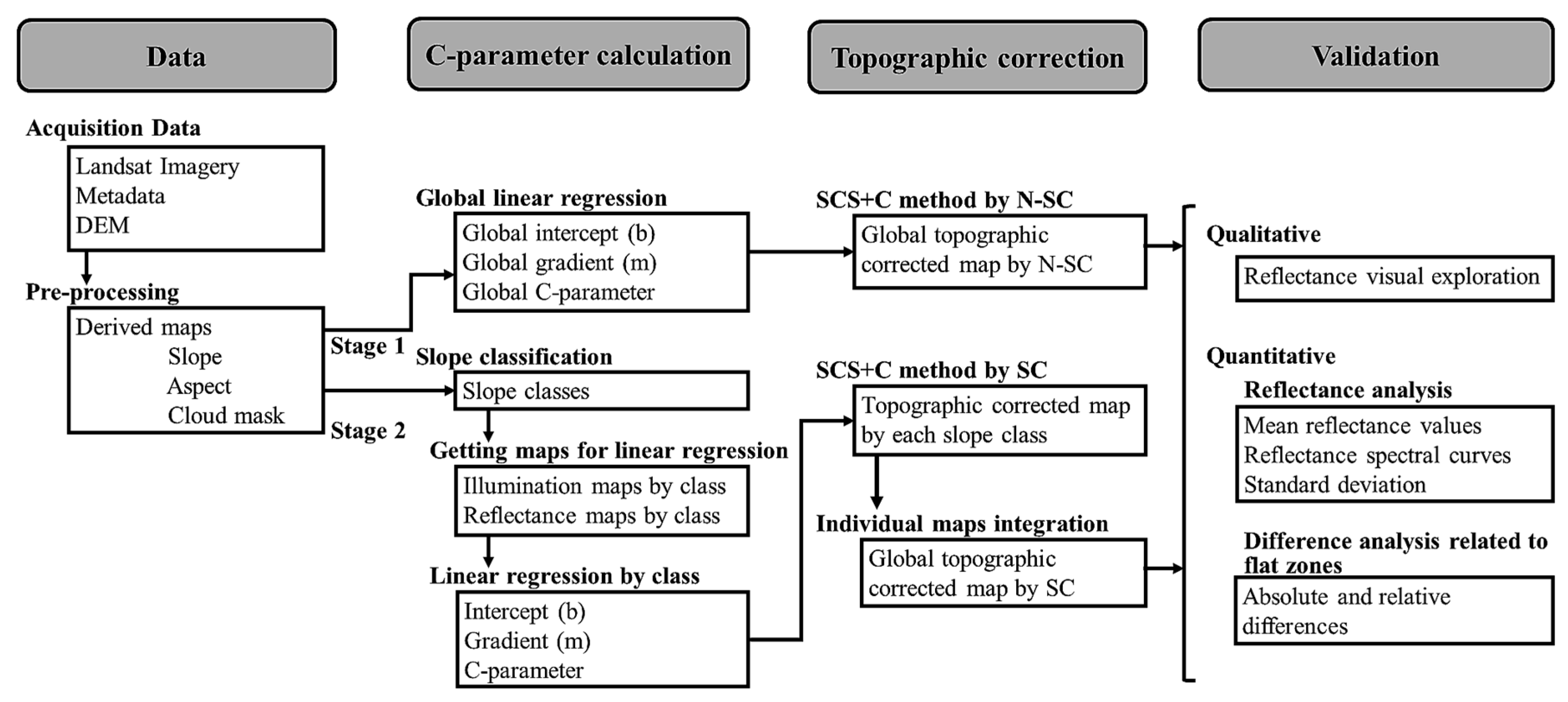
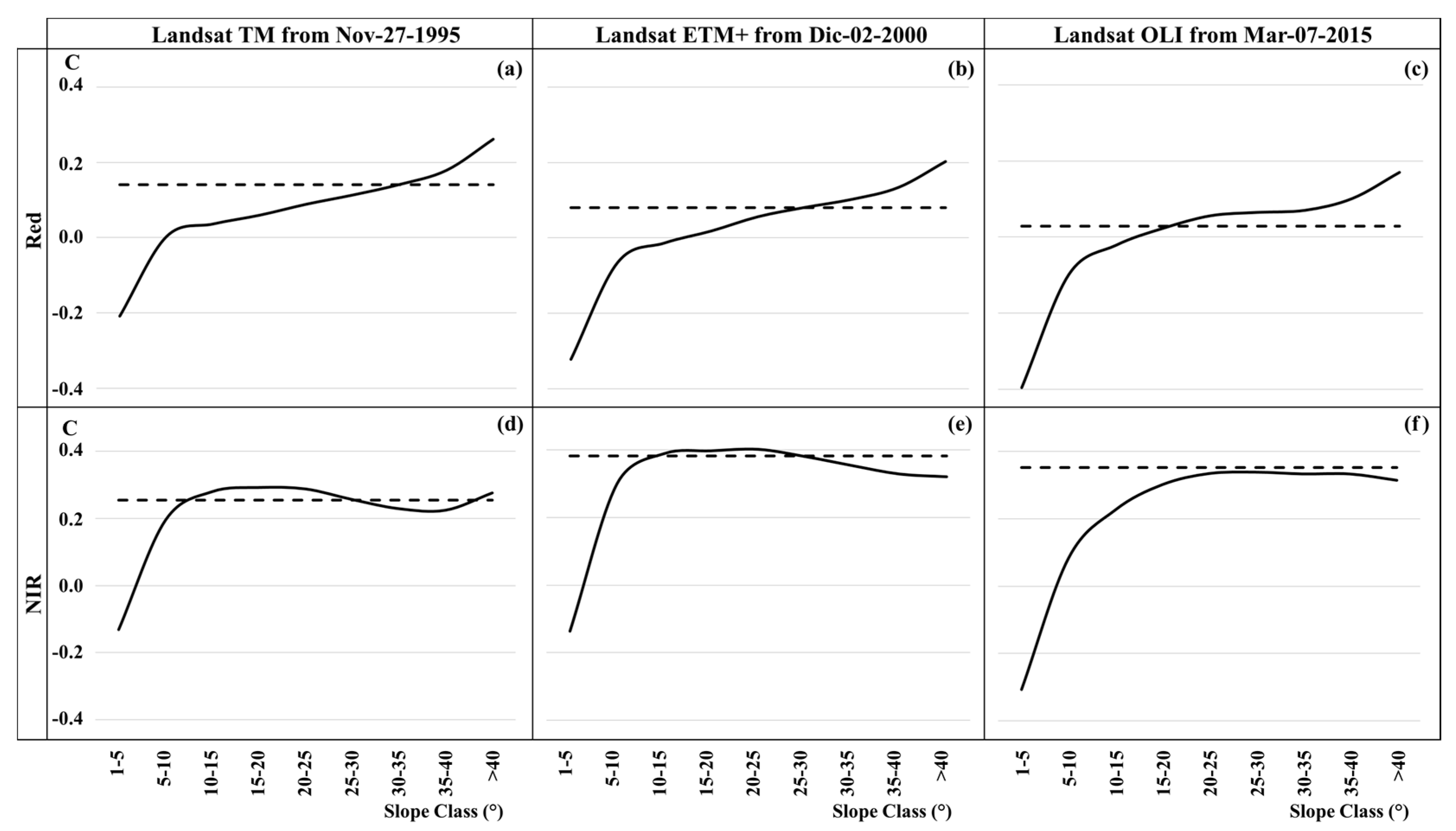
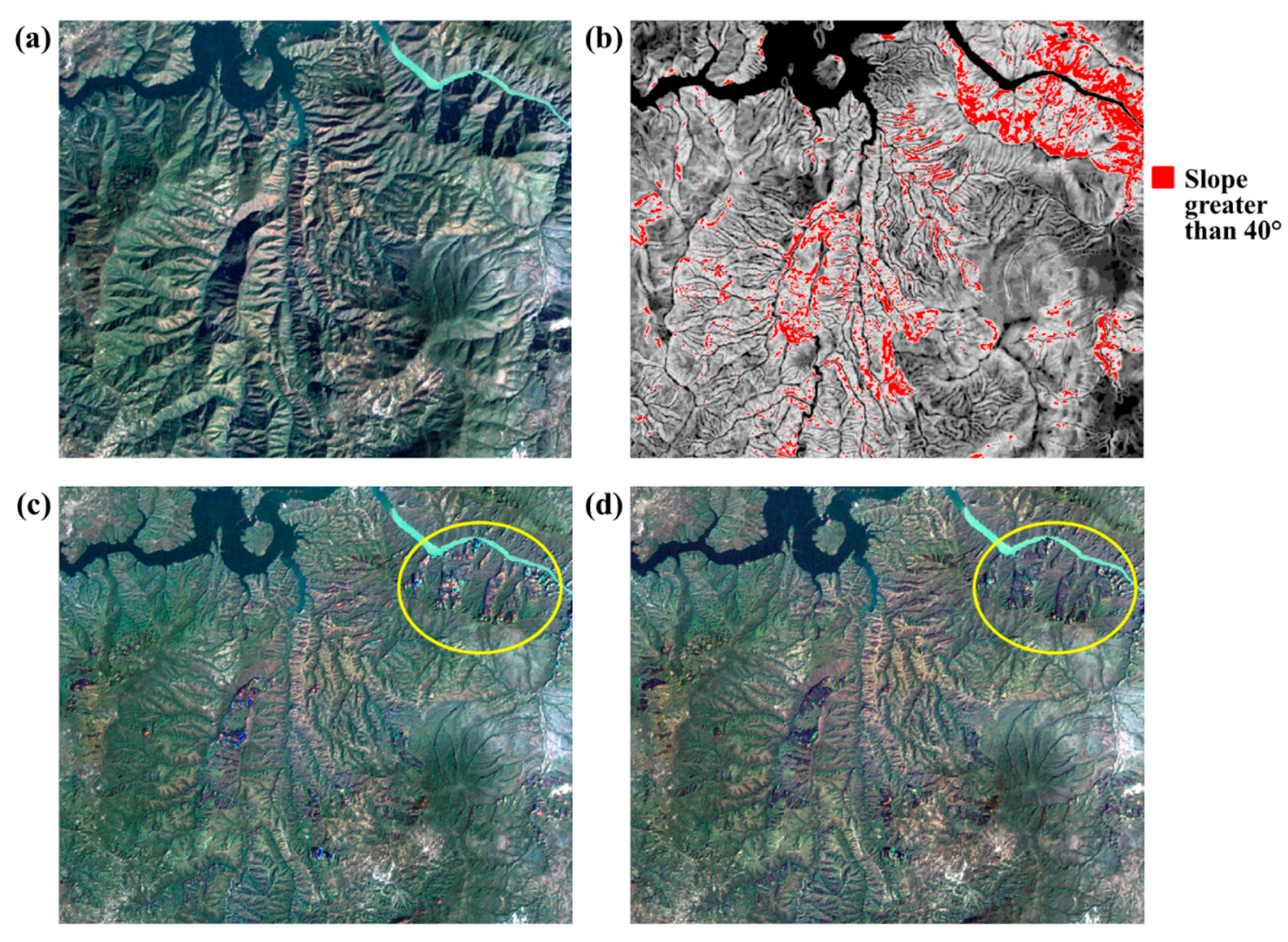

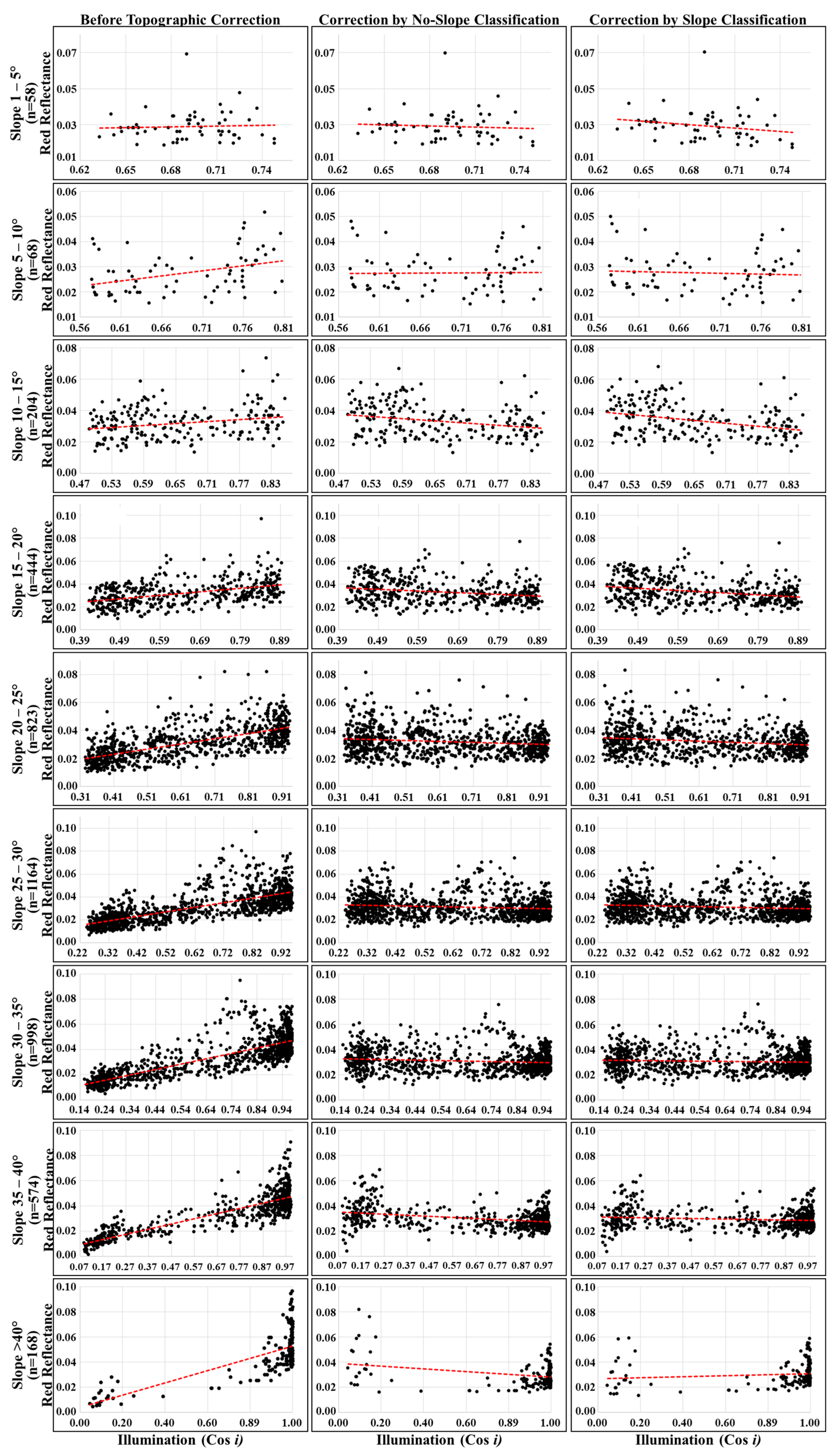
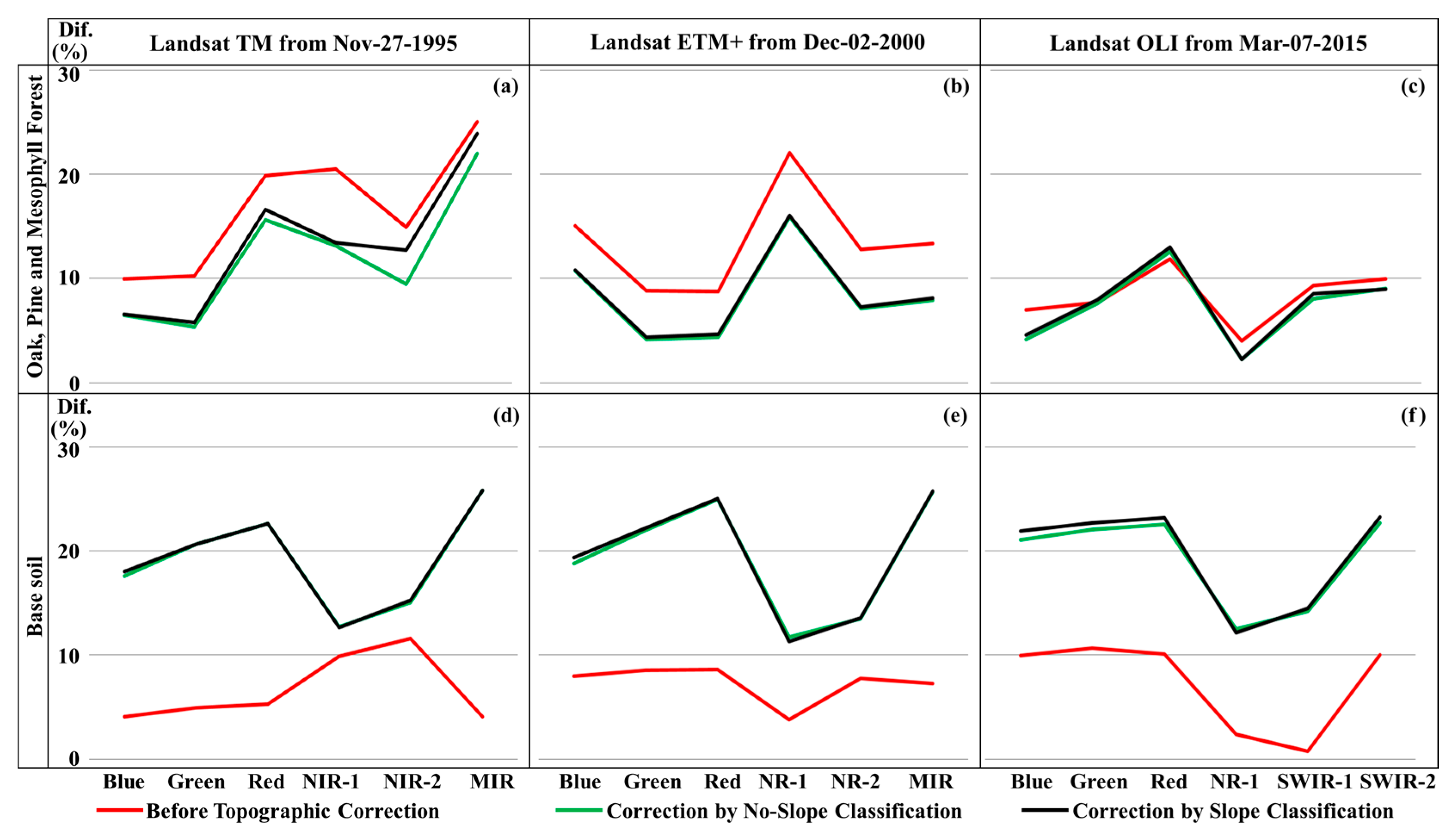
| Slope Range (Degrees) | Blue | Green | Red | ||||||
| Before Topographic Correction | After Topographic Correction | Before Topographic Correction | After Topographic Correction | Before Topographic Correction | After Topographic Correction | ||||
| NSC | SC | NSC | SC | NSC | SC | ||||
| 0 | 0.001900 | 0.001900 | 0.001900 | 0.001950 | 0.001950 | 0.001950 | 0.004250 | 0.004250 | 0.004250 |
| 0–5 | 0.013751 | 0.013327 | 0.012267 | 0.017763 | 0.017104 | 0.016473 | 0.024597 | 0.023910 | 0.023361 |
| 5–10 | 0.011086 | 0.010098 | 0.009958 | 0.017830 | 0.015883 | 0.015559 | 0.026320 | 0.023805 | 0.023460 |
| 10–15 | 0.007606 | 0.007311 | 0.006999 | 0.012198 | 0.012493 | 0.010869 | 0.019126 | 0.018849 | 0.018024 |
| 15–20 | 0.007812 | 0.007035 | 0.006688 | 0.012705 | 0.011657 | 0.010070 | 0.019961 | 0.018610 | 0.017696 |
| 20–25 | 0.008020 | 0.006162 | 0.006114 | 0.013389 | 0.009153 | 0.009129 | 0.020869 | 0.016726 | 0.016681 |
| 25–30 | 0.009193 | 0.005697 | 0.005632 | 0.015439 | 0.008115 | 0.008129 | 0.024129 | 0.015140 | 0.014469 |
| 30–35 | 0.010471 | 0.005997 | 0.005306 | 0.017782 | 0.008040 | 0.007956 | 0.027715 | 0.014425 | 0.014597 |
| 35–40 | 0.012065 | 0.006011 | 0.005624 | 0.020207 | 0.008393 | 0.008073 | 0.031428 | 0.014754 | 0.014253 |
| >40 | 0.010681 | 0.005576 | 0.004863 | 0.016891 | 0.007736 | 0.006685 | 0.026821 | 0.012521 | 0.012348 |
| Mean | 0.0093 | 0.0069 | 0.0065 | 0.0146 | 0.0101 | 0.0095 | 0.0225 | 0.0163 | 0.0159 |
| Slope Range (Degrees) | NIR | SWIR 1 | SWIR 2 | ||||||
| Before Topographic Correction | After Topographic Correction | Before Topographic Correction | After Topographic Correction | Before Topographic Correction | After Topographic Correction | ||||
| NSC | SC | NSC | SC | NSC | SC | ||||
| 0 | 0.001600 | 0.001600 | 0.001600 | 0.011500 | 0.011500 | 0.011500 | 0.011300 | 0.011300 | 0.011300 |
| 0–5 | 0.036802 | 0.040528 | 0.035932 | 0.051788 | 0.051009 | 0.050826 | 0.032628 | 0.031824 | 0.031451 |
| 5–10 | 0.041117 | 0.037700 | 0.037598 | 0.056254 | 0.048682 | 0.047999 | 0.035409 | 0.030940 | 0.030606 |
| 10–15 | 0.038907 | 0.032436 | 0.032408 | 0.052968 | 0.055306 | 0.053324 | 0.034948 | 0.042554 | 0.037259 |
| 15–20 | 0.038956 | 0.026461 | 0.026356 | 0.055030 | 0.054266 | 0.052127 | 0.037186 | 0.039461 | 0.039795 |
| 20–25 | 0.046301 | 0.024951 | 0.024864 | 0.060509 | 0.047032 | 0.047063 | 0.038412 | 0.034607 | 0.034536 |
| 25–30 | 0.054354 | 0.025649 | 0.025612 | 0.070343 | 0.040122 | 0.040115 | 0.043057 | 0.029706 | 0.029589 |
| 30–35 | 0.062579 | 0.025948 | 0.025903 | 0.080255 | 0.035384 | 0.035402 | 0.047510 | 0.025285 | 0.025069 |
| 35–40 | 0.069260 | 0.024018 | 0.023934 | 0.089130 | 0.034415 | 0.034146 | 0.054435 | 0.025196 | 0.024542 |
| >40 | 0.055517 | 0.022405 | 0.022856 | 0.077434 | 0.028085 | 0.027163 | 0.049983 | 0.020938 | 0.020074 |
| Mean | 0.0445 | 0.0262 | 0.0257 | 0.0605 | 0.0406 | 0.0400 | 0.0385 | 0.0292 | 0.0284 |
| Slope (°) | R2 Before Correction | R2 After N-SC Correction | R2 After SC Correction |
|---|---|---|---|
| 25–30° | 0.5252 | 0.0173 | 0.0168 |
| 30–35° | 0.6239 | 0.0141 | 0.0030 |
| 35–40° | 0.6992 | 0.1025 | 0.0121 |
| >40° | 0.5237 | 0.0897 | 0.0171 |
| Slope range (Degrees) | Blue | Green | Red | |||||||||||||||
| Before Topographic Correction | After Topographic Correction | Before Topographic Correction | After Topographic Correction | Before Topographic Correction | After Topographic Correction | |||||||||||||
| N-SC | SC | N-SC | SC | N-SC | SC | |||||||||||||
| 0 | 0.0000 | 0.0% | 0.0000 | 0.0% | 0.0000 | 0.0% | 0.0000 | 0.0% | 0.0000 | 0.0% | 0.0000 | 0.0% | 0.0000 | 0.0% | 0.0000 | 0.0% | 0.0000 | 0.0% |
| 0–5 | 0.0033 | 9.9% | 0.0033 | 10.0% | 0.0023 | 6.9% | 0.0000 | 0.0% | 0.0001 | 0.1% | 0.0002 | 0.3% | −0.0040 | 5.5% | −0.0039 | 5.4% | −0.0037 | 5.2% |
| 5–10 | 0.0007 | 2.0% | 0.0007 | 2.1% | 0.0007 | 2.2% | −0.0029 | 5.0% | −0.0030 | 5.1% | −0.0029 | 5.0% | −0.0091 | 12.5% | −0.0093 | 12.8% | −0.0093 | 12.8% |
| 10–15 | −0.0008 | 2.4% | 0.0006 | 1.8% | 0.0007 | 2.2% | −0.0047 | 8.0% | −0.0024 | 4.1% | −0.0022 | 3.7% | −0.0102 | 14.0% | −0.0072 | 9.9% | −0.0070 | 9.6% |
| 15–20 | −0.0013 | 4.0% | 0.0003 | 0.9% | 0.0003 | 0.9% | −0.0060 | 10.3% | −0.0035 | 5.9% | −0.0035 | 5.9% | −0.0106 | 14.6% | −0.0071 | 9.8% | −0.0071 | 9.8% |
| 20–25 | −0.0032 | 9.6% | −0.0017 | 4.9% | −0.0018 | 5.3% | −0.0088 | 15.0% | −0.0064 | 11.0% | −0.0066 | 11.3% | −0.0150 | 20.7% | −0.0120 | 16.6% | −0.0123 | 16.9% |
| 25–30 | −0.0035 | 10.4% | −0.0022 | 6.6% | −0.0025 | 7.4% | −0.0090 | 15.5% | −0.0072 | 12.4% | −0.0076 | 13.0% | −0.0160 | 22.0% | −0.0143 | 19.7% | −0.0146 | 20.1% |
| 30–35 | −0.0012 | 3.4% | −0.0017 | 5.2% | −0.0020 | 5.8% | −0.0052 | 9.0% | −0.0066 | 11.3% | −0.0068 | 11.7% | −0.0100 | 13.8% | −0.0127 | 17.4% | −0.0129 | 17.8% |
| 35–40 | 0.0022 | 6.5% | −0.0016 | 4.7% | −0.0017 | 5.0% | 0.0005 | 0.9% | −0.0062 | 10.6% | −0.0063 | 10.9% | −0.0020 | 2.8% | −0.0117 | 16.1% | −0.0119 | 16.3% |
| >40 | 0.0073 | 21.8% | −0.0032 | 9.5% | −0.0021 | 6.1% | 0.0078 | 13.3% | −0.0111 | 19.1% | −0.0082 | 14.1% | 0.0094 | 13.0% | −0.0162 | 22.4% | −0.0126 | 17.3% |
| Mean | 7.0% | 4.6% | 4.2% | 7.7% | 8.0% | 7.6% | 11.9% | 13.0% | 12.6% | |||||||||
| Std. Dev. | 0.0032 | 0.0019 | 0.0016 | 0.0051 | 0.0035 | 0.0031 | 0.0077 | 0.0050 | 0.0047 | |||||||||
| Slope range (Degrees) | NIR | SWIR 1 | SWIR 2 | |||||||||||||||
| Before Topographic Correction | After Topographic Correction | Before Topographic Correction | After Topographic Correction | Before Topographic Correction | After Topographic Correction | |||||||||||||
| N-SC | SC | N-SC | SC | N-SC | SC | |||||||||||||
| 0 | 0.0000 | 0.0% | 0.0000 | 0.0% | 0.0000 | 0.0% | 0.0000 | 0.0% | 0.0000 | 0.0% | 0.0000 | 0.0% | 0.0000 | 0.0% | 0.0000 | 0.0% | 0.0000 | 0.0% |
| 0–5 | −0.0062 | 2.7% | −0.0056 | 2.5% | −0.0045 | 2.0% | −0.0269 | 11.4% | −0.0263 | 11.2% | −0.0257 | 10.9% | −0.0131 | 9.9% | −0.0129 | 9.8% | −0.0126 | 9.5% |
| 5–10 | −0.0068 | 3.0% | −0.0059 | 2.6% | −0.0053 | 2.3% | −0.0338 | 14.3% | −0.0335 | 14.2% | −0.0333 | 14.1% | −0.0176 | 13.3% | −0.0176 | 13.3% | −0.0175 | 13.3% |
| 10–15 | −0.0035 | 1.5% | 0.0034 | 1.5% | 0.0046 | 2.0% | −0.0216 | 9.2% | −0.0113 | 4.8% | −0.0101 | 4.3% | −0.0114 | 8.6% | −0.0046 | 3.5% | −0.0040 | 3.1% |
| 15–20 | −0.0031 | 1.4% | 0.0046 | 2.0% | −0.0064 | 2.8% | −0.0177 | 7.5% | −0.0056 | 2.4% | −0.0047 | 2.0% | −0.0102 | 7.7% | −0.0022 | 1.7% | −0.0057 | 4.3% |
| 20–25 | −0.0050 | 2.2% | 0.0022 | 1.0% | 0.0024 | 1.1% | −0.0275 | 11.7% | −0.0169 | 7.2% | −0.0168 | 7.1% | −0.0175 | 13.2% | −0.0104 | 7.9% | −0.0105 | 8.0% |
| 25–30 | −0.0018 | 0.8% | 0.0036 | 1.6% | 0.0038 | 1.7% | −0.0303 | 12.9% | −0.0231 | 9.8% | −0.0233 | 9.9% | −0.0213 | 16.1% | −0.0164 | 12.4% | −0.0167 | 12.7% |
| 30–35 | 0.0071 | 3.1% | 0.0008 | 0.3% | 0.0009 | 0.4% | −0.0147 | 6.3% | −0.0220 | 9.3% | −0.0223 | 9.5% | −0.0124 | 9.4% | −0.0157 | 11.9% | −0.0163 | 12.3% |
| 35–40 | 0.0222 | 9.8% | −0.0033 | 1.5% | −0.0034 | 1.5% | 0.0037 | 1.6% | −0.0266 | 11.3% | −0.0269 | 11.4% | −0.0013 | 1.0% | −0.0180 | 13.6% | −0.0186 | 14.1% |
| >40 | 0.0355 | 15.7% | −0.0218 | 9.6% | −0.0190 | 8.4% | 0.0433 | 18.4% | −0.0353 | 15.0% | −0.0271 | 11.5% | 0.0268 | 20.3% | −0.0206 | 15.5% | −0.0173 | 13.1% |
| Mean | 4.0% | 2.3% | 2.2% | 9.3% | 8.5% | 8.1% | 10.0% | 9.0% | 9.0% | |||||||||
| Std. Dev. | 0.0141 | 0.0079 | 0.0069 | 0.0232 | 0.0116 | 0.0108 | 0.0139 | 0.0072 | 0.0066 | |||||||||
© 2017 by the authors. Licensee MDPI, Basel, Switzerland. This article is an open access article distributed under the terms and conditions of the Creative Commons Attribution (CC BY) license (http://creativecommons.org/licenses/by/4.0/).
Share and Cite
Vázquez-Jiménez, R.; Romero-Calcerrada, R.; Ramos-Bernal, R.N.; Arrogante-Funes, P.; Novillo, C.J. Topographic Correction to Landsat Imagery through Slope Classification by Applying the SCS + C Method in Mountainous Forest Areas. ISPRS Int. J. Geo-Inf. 2017, 6, 287. https://doi.org/10.3390/ijgi6090287
Vázquez-Jiménez R, Romero-Calcerrada R, Ramos-Bernal RN, Arrogante-Funes P, Novillo CJ. Topographic Correction to Landsat Imagery through Slope Classification by Applying the SCS + C Method in Mountainous Forest Areas. ISPRS International Journal of Geo-Information. 2017; 6(9):287. https://doi.org/10.3390/ijgi6090287
Chicago/Turabian StyleVázquez-Jiménez, René, Raúl Romero-Calcerrada, Rocío N. Ramos-Bernal, Patricia Arrogante-Funes, and Carlos J. Novillo. 2017. "Topographic Correction to Landsat Imagery through Slope Classification by Applying the SCS + C Method in Mountainous Forest Areas" ISPRS International Journal of Geo-Information 6, no. 9: 287. https://doi.org/10.3390/ijgi6090287





